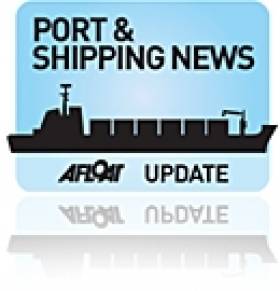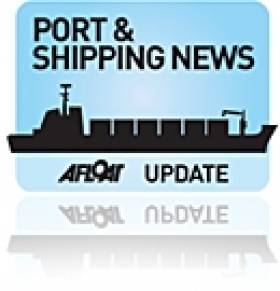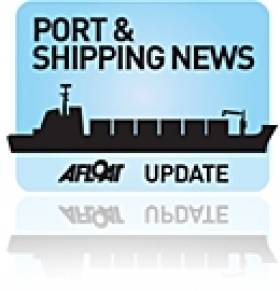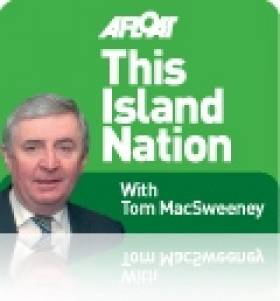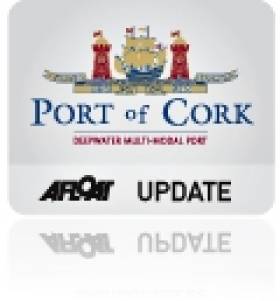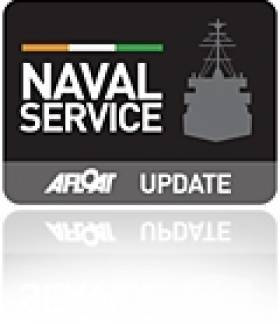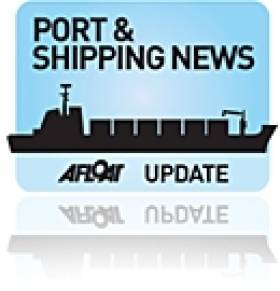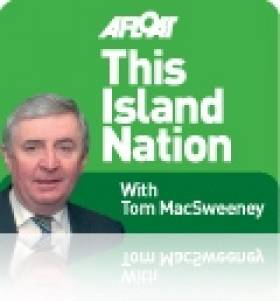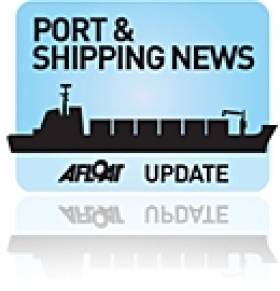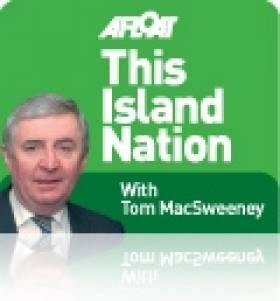Displaying items by tag: Shipping
IMDO Shipping Review: Asia Trade Grows, Scrapping Increases
#Shipping - The latest Weekly Shipping Market Review from the Irish Marine Development Office (IMDO) reports of strong Asia trade in the container market, and a growing sense of optimism among clean product tankers.
Container trade growth is expected to rise to 6.1 per cent in 2013 driven in part by strong business in Asia, which will see some modest growth at a slower pace than elsewhere throughout the year.
Demand in the tanker market is highest among smaller vessels and those handling clean products, while the crude oil market faces "another challenging year". Profits for product tankers in the Atlantic basin are up, and the fleet is looking forward to a year of growth.
The flipside of this is that more and more ships are facing a future in the scrapyard as the dry bulk market continues to stagnate and shipowners race to cut their costs.
The complete Shipping Markets Review for week 7 is available as a PDF to read or download HERE.
Paris To Host Shortsea 13 Convention
#Shipping - The European Shortsea Conference will take place for the first time in France on Thursday 14 March 2013.
Shortsea 13 at La Defense in Paris is organised by the Bureau de Promotion du Shortsea Shipping (BP2S) and SPC France jointly with other European Shortsea promotion centres - and comes just weeks after the Euromaritime exposition that kicks of tomorrow in the French capital.
The conference will cover a number of hot topics related to shorts and intermodal intra-european transport, the challenges that exist and are yet to come, and what solutions can be found.
And like last year's event, hosted in Dublin by the Irish Maritime Development Office (IMDO) and Coastlink, the convention will provide a platform to network, discuss and debate issues shared by European shipping partners.
Organisers say that contributors are still welcome to take part as speakers (e-mail [email protected] for more) or sponsors (contact [email protected] for details).
Registrations will open soon for those wishing to attend as delegates. Keep an eye on the Shortsea 13 blog or find more information on the European Shortsea Network at www.shortsea.info.
GPS Backup Goes Live in World's Busiest Shipping Lane
#Shipping - The General Lighthouse Authorities of the UK and Ireland (GLA) have announced that ships in the Port of Dover, its approaches and part of the Dover Strait can now use eLoran radio navigation technology as a backup to satnav systems like GPS and Galileo.
The ground-based eLoran system provides alternative position and timing signals for improved navigational safety.
The Dover area, the world's busiest shipping lane, is the first in the world to achieve this initial operational capability (IOC) for shipping companies operating both passenger and cargo services.
This recent announcement represents the first of up to seven eLoran installations to be implemented along the East Coast of the United Kingdom.
The Thames Estuary and approaches up to Tilbury, the Humber Estuary and approaches, and the ports of Middlesbrough, Grangemouth and Aberdeen will all benefit from new installations, and the prototype service at Harwich and Felixstowe will be upgraded.
Although primarily intended as a maritime aid to navigation, eLoran could become a cost-effective backup for a wide range of applications that are becoming increasingly reliant on the position and timing information provided by satellite systems.
"Our primary concern at the GLA is for the safety of mariners," said Ian McNaught, chief executive of Trinity House, "But signals from eLoran transmitters could also provide essential backup to telecommunications, smart grid and high frequency trading systems vulnerable to jamming by natural or deliberate means.
"We encourage ship owners and mariners to assess eLoran in this region and provide feedback to the GLA on its performance."
P&O Ferries has installed an eLoran receiver on its new vessel Spirit of Britain. She will be based at Dover and is one of the largest passenger ships the busy Dover/Calais route has ever seen.
"Accurate real-time positional information is essential for the safe navigation of ships with modern electronic charts," said Captain Simon Richardson, head of safety management at P&O Ferries.
"Satellite navigation systems are vulnerable to degradation of signal strength and our ships have also experienced occasional loss of signal.
"We welcome the development of a robust alternative to provide redundancy in real-time positional information and we see eLoran as the most effective solution to countering the problem."
Commenting on the announcement, Britain's Shipping Minister Stephen Hammond said: "I congratulate the General Lighthouse Authorities on this initiative which seeks to improve navigational safety in what is the busiest shipping channel in the world, through the development and deployment of technology. I look forward to receiving reports of its effectiveness."
Ports Call for Co-ordinated Action, National Marine Plan & Col Regs
#islandnation – In THIS ISLAND NATION this week .... Determination at 70 .... The ports call for co-ordinated Government action .... Why is the public starved of information about the national marine plan? .... Galway Bay environmental controversy and who are the lobbying groups? ... Are the collision regulations understood and next year's coastal sailing gathering....
SAILING – OLDEST BUT NOT FINISHED
Sailing is a sport for all, at all ages and competitive sailing can vary from single-handed or fully-crewed racing boats to individual challenges, but round-the-world solo sailors are a breed apart.
Last Monday the oldest woman to sail solo around the world left Canada for her third attempt to do so non-stop. On two previous attempts she completed circumnavigations but stops in various ports caused by gear failure and damage at sea frustrated her non-stop attempts. With the distinguished surname of one of the great philosophers, 70-year-old Jeanne Socrates, left Victoria in Western Canada on the third attempt in her Najad 380 yacht, Nereida. She was forced to stop on Cape Town for repairs during her first attempt in 2009, which started in Lanzarote. A second non-stop attempt in October 2010 ended with a knockdown 100 miles west of Cape Horn the following January. However, she did manage to complete the single-handed circumnavigation last August after stopping in the Falklands, Cape Town, Tasmania, Tahiti and Hawaii.
"This is like any sporting challenge, I want to do it non-stop and I am determined to achieve it and be back here successfully, hopefully without any serious incidents along the way," she said on leaving!
PORTS – DUBLIN, CORK, SHANNON-FOYNES TOP PORT PROSPECTS
Since the launch of the Ocean Strategy Plan by the Government during the Summer there has been a lack of official information about progress on its implementation. The public is entitled to a better level of information about the implementation of plans which are announced with much publicity hype.
The Irish Maritime Development Office this week published its review of the capability of Irish ports to meet development requirements for the marine renewable energy. It reported a "consensus" amongst the ports on the absence of "any clear policy framework at a national level for the development of an ocean energy industry with the necessary political will to invest in the business."
This challenges the difference between what has been publicly said by various Government Ministers and what the Government is actually doing. My sources in the industry tell of dissatisfaction with attitudes they encounter. Consultations with some of the ports for the report were undertaken before the Government's marine plan "Harnessing Our Ocean Wealth," was published. This identified potential of the offshore ocean energy sector and proposed an action plan but not a lot has been heard about its implementation. The IMDO report has identified the need for clear, co-ordinated Government action to take advantage of the possibility of creating hundreds of jobs.
There was also general consensus amongst the ports about the need for a national website integrating information about Irish ports in terms of infrastructure and facilities to support construction and fabrication; operation, maintenance and servicing; and research and development. The IMDO says that this is something that would be relatively inexpensive for the Government to create and could be used as a central marketing and information platform by Government agencies and departments in communicating where national strategic competitive advantages lie.
Let's see if the Government's marine co-ordinating group responds positively or at all.
ENVIRONMENT – GALWAY BAY FISH FARM
The State fisheries board, Bord Iascaigh Mhara (BIM), has strongly attacked the environmental group, Friends of the Irish Environment and called on it to withdraw what is has described as a "spurious allegation" and apologise for what it alleges is a "slur" on BIM's reputation.
The row is over a claim by FIE that BIM suppressed reports regarding its application for an organic salmon farming license in Galway Bay which aims to create 500 jobs. The public consultation period for the project is underway, and closes at midnight on December 12. BIM has rejected the FIE allegation.
I will be interested to see how this develops.
There is a general issue about all environmental lobbying groups which, in terms of transparency, fairness and balance in public debate should be addressed. In dealing with State or public bodies we know information about them that is publicly available but there are so many different lobbying groups that a register of information about them, their membership strengths, who they represent, their financing, etc., would enable better assessment of their views.
SHIPPING – ARE COLLISION REGULATIONS UNDERSTOOD?
The Nautical Institute, the international professional body for seafarers, has raised the question of whether COLREGs are fully understood and if a lack of knowledge about them could be putting ships at risk.
In its journal SEAWAYS the Chief Executive, Philip Wake, says: "There appears to be a fundamental lack of understanding of the regulations by far too many mariners." The issue is discussed in the context of the 20th anniversary of the launching of the Mariners' Alerting and Reporting Scheme.
It could be added that there are many leisure sailors who also do not understand the collision regulations.
SAILING – GATHERING CRUISE
The Irish Marine Federation and Irish Sailing Association have announced 'The Gathering Cruise' as part of next year's plans for the celebration of the Irish diaspora.
It will take place from July 13 to August 1, with over 100 boats congregating in 'Gathering Ports' across the UK before sailing together to Ireland. "The Gathering Flotilla will assemble in Kinsale for a welcome reception," says the ISA and then "flotillas will have an opportunity to explore the coastline of West Cork and Kerry for a week of unscheduled cruising. All boats will then gather again in Dingle, Co. Kerry for a Gathering Cruise farewell reception and 'scattering' where boats will have the option to continue their cruise in a northerly direction in the company of other cruise participants. Gathering Welcome Ambassadors will be available in Welcome Ports along the Irish coastline."
BOOKS – JEANIE SHOULD HAVE BEEN A DIFFERENT COLOUR!
With the Jeanie Johnston hosting maritime stories aboardship in Dublin Port as to the atmospheric creaking sounds of the famine Ship's hull enveloping the audience I was interested to read that there was an original colour scheme for the Jeanie Johnston that would have made her stand out strikingly at sea – all yellow sails, red-coloured masts and a bright orange decorative strip with false black porthole outlets on the hull. That was proposed by Fred Walker, the ship's architect. When completed the tall ship was less dramatic in appearance – traditional white sails, natural wooden masts and a white strip with false black portholes.
That was one conception, reproduced in this book which was changed.
This book is predominantly a photographic record by the author who voyaged in her in 2005, Liverpudlian Michael English. My particular favourite picture is that of the two crew members who found a spot aloft to have an 'al fresco' lunch, while the one of crew members furling sail on the topsail yard will test your head for heights!
Sailing the Irish Famine Tall Ship Jeanie Johnston, by Michael English, published by Collins Press €29.99
Email your comments on maritime matters to: [email protected]
Follow @TomMacSweeney
Port of Cork Bucks Shipping Trend with Traffic Volume up 5%
#portofcork – The Port of Cork Company has reported increased total traffic volumes of over 5% for the first six months of 2012. This is in strong contrast with recent figures released by the Irish Maritime Development Office (IMDO) which showed a significant decrease in shipping volumes across Irish ports when six key seaports are taken into account.
Container traffic (Lo/Lo) increased by over 5% compared to the same period in 2011, with imports up nearly 6% and exports up almost 5%. Figures taking into account traffic in all Irish ports have shown a decline in imports of 4% and a decline in exports of 2% for the first six months of 2012.
Dry bulk cargoes also continued to perform well with the Port of Cork maintaining traffic volumes at 2011 levels for the first and second quarter of 2012. With a reported decline of -6% from all Irish ports, Cork has seen a notable rise in imports of animal feedstuffs and coal. Overall, bulk cargoes (break & liquid) are up 3% compared to the same period in 2011.
Port of Cork continues to see an increase in oil traffic with imports over 6% and exports up 7% while non-oil traffic also increased by 3% when compared to the same period in 2011.
Commenting on the traffic figures for the Port of Cork, Brendan Keating CEO said "2012 to date has seen our traffic volumes in a growth mode as we continue to serve as Southern Ireland's gateway for trade. The Port of Cork is perfectly placed as a trading hub for European and the American Markets with its deep water facilities and as such we are continuing to expand and grow our facilities to meet our customer's demands. As a port, our strength is in the diversity of our trades such as oil, chemicals, gas, coal, wood, animal feed, fertiliser, off-shore supply and ferries."
Another growth sector is our cruise business with the Port of Cork welcoming a total of 60 cruise liners calling in 2012, bringing over 100,000 passengers and crew to the region. The ports deep water and dedicated cruise terminal means it is the only port in Ireland capable of handling these vessels alongside. These cruise visits are estimated to bring in some €17 million and 200 full-time-equivalent jobs to the local economy.
#NAVAL SERVICE - The Irish Times reports that a Russian vessel suspected of shipping arms to Syria was under surveillance by the Naval Service earlier this week.
The 130m cargo ship MV Alaed - with a stated destination of Vladivostok in the far east of Russia - appeared to be headed for the western coast of Ireland, and the Naval Service were preparing to board and search the ship pending legal advice.
But the Naval Service and Irish Coast Guard both stood down their watch when the vessel changed course off Scotland, after its insurance cover was revoked.
Standard Club, the UK-based insurer, confirmed it withdrew its cover due to the allegations that the MV Alaed was carrying arms destined for Syria in breach of EU sanctions.
Ships have the right of free passage in international waters provided they are flying their flag and pose no imminent threat to the marine environment.
The Irish Times has more on the story HERE.
Polish Captain Sentenced After Shipping Collision
#SHIPPING – On 7th March 2012, Miroslaw Pozniak, the master of the merchant ship 'Union Moon', registered in the Cook Islands, was outbound from the port of Belfast when he collided with the inbound ferry 'Stena Feronia'
There were 51 passengers and 47 crew onboard the ferry and six people onboard the cargo ship. Fortunately no one was injured in the collision, however there was substantial damage to both ships.
The two ships were approaching the fairway buoy which marks the beginning of the main channel into Belfast harbour. As the 'Union Moon' passed the Fairway Buoy, she should have altered course to starboard on to an easterly heading, but unexpectedly altered course to port in to the port side of the approaching ferry.
Captain Pozniak pleaded guilty at court in Newtonards on the 12 March 2012 to breaches of the Railways and Transport Act 2003 by being four times over the alcohol limit. At a later hearing he was also charged with failing to keep a proper lookout and to causing serious damage to his own ship and to the 'Stena Feronia'.
Sentencing Mr Pozniac at Downpatrick Crown Court the Judge said:
"I believe that any sentence cannot be suspended. This sentence makes it clear that the following of the regulations, both in relation to alcohol and also in relation to the charting and proper adherence to accepted routes, is of vital importance. The ending of your 30 year career and this sentence effectively demonstrate that."
The Master was given a custodial sentence of 12 months on each of the three counts to run concurrently.
Captain Bill Bennett, Area Operations Manager (Survey and Inspection) for the MCA said;
"This was a very serious accident. It could so easily have been a dreadful tragedy but fortunately there were no injuries or fatalities. It is a matter of concern to the MCA that misuse of alcohol continues to play a part in a number of maritime accidents."
#ISLANDNATION – The sinking of the Titanic in 1912, remembered so much this year in the centenary of the disaster, is probably the most well-known shipwreck, but it is not the greatest maritime disaster ever. If you want to know what that was, go to the full edition of THIS ISLAND NATION, where this week there is more about shipping, the marine environment, fishing and many other aspects of the maritime world. The great variety of the marine sector is what makes it so interesting to write about and report.
The announcement today that, with jobs needed, 21 seafood companies are to provide 142 in Wexford, Dublin, Cork, Donegal, Galway, Louth and Kerry, underlines the importance of the fishing industry which should indicate its economic benefits. It is good to see the industry advancing.
The Irish Ports and Shipping sector is heavily influenced by events globally and, as Glenn Murphy, Director of the Irish Maritime Development Office has pointed out, when the volume of shipping and port traffic drops, that indicates the problems in the Irish economy. This is another example of how this nation depends on the sea. The latest figures were released to the European Shortsea Conference in Dublin yesterday.
Fall in First Quarter of Shipping Volumes
#SHIPPING – The volume of shipping and port traffic through the Republic of Ireland declined in the first quarter of 2012. This is according to the latest figures released by the Irish Maritime Development Office (IMDO) at the European Shortsea Conference being held at the Mansion House in Dublin today.
The first quarter data indicates that only 1 of the 5 principal freight segments had any growth over the first quarter while all other freight segments declined or recorded no growth compared to the same period last year.
KEY DATA INDICATORS:
Freight Segments:
- Lift-on/Lift-off (Lo/lo) trades were down -1%.
- Roll-on/Roll-off (Ro/ro) declined by -3%.
- Dry bulk volumes was unchanged 0%,
- Tanker/Liquid bulk market was up +30%.
- Break bulk volumes were down by -4%
Total container traffic (Lo/lo) declined by 1% during the first three months of the year. Exports a subset of these figures grew by 1% in the first quarter as weakened economic trading conditions prevailed internationally, in particular in Europe. Imports fell by 2% in the first quarter. This represents the 17th consecutive quarter of declining import volumes. As a result, this has seen shipping and logistics firms strategically importing empty containers to address the reduction of laden containers imports into Ireland in recent years. In Quarter 1 2012 alone, the IMDO have calculated that 5% more empty containers were imported into Ireland to meet exporters needs.
Roll-on/roll-off (ro/ro) traffic declined in the Republic of Ireland by 3%. The majority of Ro/Ro freight from Ireland is destined for the United Kingdom. This decline in traffic is clearly reflected in the continued uncertainly in UK as their economy shrank in the first quarter, sliding into its first double dip recession since the 1970's. A considerable amount of Ro-Ro freight is destined for supermarket multiple and FMCG sectors both domestically and cross channel. These sectors particularly in the UK have reported significant downturns in sales in 2012 so far.
Dry bulk volumes were stagnant through Irish ports during the first three months of 2012. However, animal feed, peat moss and iron ore are significant products in this freight segment and ones which continue to perform strongly. Demand for aluminum remained strong internationally, particularly from China.
Liquid bulk volumes of tanker based petroleum products increased by 30% in the first quarter. This increase was driven by Bantry Bay which recorded a marked increase in its international trans-shipment activity at its crude oil and products facility. Domestic oil consumption remained weak and if we exclude trans-shipment storage, then volumes would have increased by just over 1%.
Break bulk volumes have continued its decline into Quarter 1, by 4 per cent. This freight segment was extensively linked to the construction boom as products shipped in this segment include timber and steal. Break volumes passing through Irish ports have declined by 40 per cent since 2008 but this rate of decline has eased considerably since 2010. Scrap metal exports continued to increase in volume as this commodity's price remains high into 2012.
Outlook:
The Irish Ports and Shipping sector is heavily influenced by events globally. As the stability of the European economy remains fragile, uncertainty for Irish consumers and businesses will inevitably persist, which will be clearly reflected in freight volumes passing through Irish ports. Exports in the short-term will continue to drive economic growth, which has been aided by favourable exchange rates in recent months. The Port of Rotterdam, which is Ireland's main Deep-Sea connection to countries outside of Europe, is optimistic that their volumes will show a modest increase in the latter half of 2012, which is a good sign for Irish businesses exporting globally.
Keynote speech delivered by Mr Leo Varadkar T.D. Minister for Transport, Tourism and Sport at the European Shortsea Convention 2012
Round Room, Mansion House, Dublin.
May 24th 2012
Mr. Chairman, Ladies and Gentlemen, distinguished guests
I'm delighted to have the opportunity to address this European Shortsea conference today. First of all, I should like to congratulate both the IMDO and Coastlink on taking the initiative to organize this year's conference, and for assembling such a strong lineup of speakers. Speaking as Minister for Tourism I should also like to welcome all those delegates that have travelled from overseas to participate at this year's event.
Today's European conference is timely. Important questions are being debated here and internationally about the challenges facing the Eurozone.
The European Commission has identified Ports and Shipping as important engines for future economic growth. The latest estimate from the European Commission identifies that over 800,000 enterprises, employing more than 3 million people directly, are located within European port community clusters.
European ports are already the transit point for up to 90% of Europe's freight movements with the rest of the world, and 40% of the internal market. The internal market in Europe still accounts for over 60% of all of Ireland's trade, which in itself signifies the important role that shortsea services play in the day to day competitiveness of Ireland's economy.
I understand that this is the fourth time that this Conference has been hosted in Ireland but it is my first opportunity to speak at this event since our Government came into office last year. I know that there are many delegates from across Europe representing significant maritime interests, with investments directly in Ireland, or, connected to a service from Ireland.
It is important therefore to tell you that one of the key priorities of the current government when elected was to restore the standing of Ireland, and in particular, restore our reputation as a place to do business. Despite the prevailing turbulent global and European economic environment, Ireland has made significant progress in bringing our public finances under control and returning our economy to export led growth.
Our current balance of payments is positive. We are forecasting modest GDP growth this year, while the European Commission expects that our GDP growth will accelerate to 2% in 2013. This has not been a painless process and individuals and business have had to make sacrifices to achieve the progress we have made so far, in order to stabilize the economy.
Ireland as an island trading economy is highly dependent on Shortsea shipping. 100% of our container and unitised traffic is carried via intra-European Shortsea services.
I wish to stress also the importance, from a Government perspective, that we continue to encourage and maintain frequent, competitive, andmodern European Shortsea shipping services from Irish Ports.
As an open economy we are more exposed to changes in the external global and European environment. The recent publication of the Irish Maritime Transport Economist by the IMDO illustrated the volatility in our economy last year.
While 2011 started positively with some economic growth in the first quarter of the year, this economic growth lost momentum as concerns about the pace of the global recovery and underlying issues in Europe started to emerge. This was mirrored in our Irish shipping volumes which had a strong first quarter before slowing down in the second quarter and turning flat to negative to year end.
The latest first quarter data for 2012 released by the IMDO shows that demand has remained relatively subdued. However, exports, which have been one of the cornerstones of our recovery over the past 3 years, rose by 3% during the first quarter.
We are confident that when the Eurozone economy returns to growth, that Ireland, with its lower operating cost base and a strong export sector, will be well positioned to quickly respond to demand from the global markets. This is why it is important that we have a ports and shipping sector both in Ireland and Europe that continues to remain, efficient, effective and above all competitive.
Speaking at the recent European Ports Conference, Dimitrios Theologitis, Head of the Maritime Transport and Ports Policy Unit, outlined its plans for an industry wide consultation of European Ports Policy later this year.
The impact assessment on the revision of the EU framework for ports services was launched in 2011 and will take until the end of 2012. It will involve extensive consultation with all stakeholders and the commissioning of various fact-finding studies. It will also rely on dialogue with the social partners in the sector. The Commission will draw conclusions and they plan to put forward fine-tuned proposals in relation to future EU Ports policy in 2013.
In Ireland, I am committed to the publication of a new ports policy this year. It is crucial that Ireland's commercial ports continue to provide the best possible service to the economy at large, as it returns to growth. Planning future port capacity is one of the many issues being addressed as part of the Ports Policy Review currently underway in my Department.
Our current ports policy will require a radical overhaul. The existing structure treats our nine port companies as though they were the same size, scale and have the same role to play, while this is clearly not the case. The circumstances in each port are quite different and need to be dealt with on a case by case basis. Ports serving significantly different markets, which vary greatly in terms of size and scale, have different potential, far higher risks and have different futures.
Evidently, there is a hierarchy of ports that are made up of core ports that serve large strategic volumes of national trade, and a number of smaller ports that have a more regional role. It is vital that our new national ports policy provides an appropriate framework for our commercial ports. A framework that allows our ports develop and respond as required to the needs of our economy; a framework that recognises that changes at a global level requires action at a national level to ensure that Ireland is served by first class commercial seaports.
I'm committed with the officials from my Department to complete and publish this review in the coming months during which we intend to engage with the all of the stakeholders involved in this process to ensure we have a sustainable ports sector that reflects the changing transport demands of our economy.
My Department has also engaged in the recent European Commission's consultation on State Aid Guidelines for Maritime Transport. We believe that the State Aid Guidelines have broadly delivered on what they intended to achieve over the past decade and that we advocate that these guidelines should be extended, and where possible improved, to continue to underpin shipping as an important growth driver for Europe.
I am also committed to the retention of the Tonnage Tax scheme in Ireland which is directly relevant to many of our shortsea shipping companies. Since the introduction of Tonnage Tax in 2002 we have seen a tenfold increase in the number of ships, owned, managed, and operated in Ireland, directly creating new jobs and investment.
As this is a European Conference, I should like to mention the upcoming vote on the European Stability Treaty which takes place in Ireland on 31st of May. I am confident that the Irish electorate will consider fully the role they will play in this election to further improve our international reputation and ensure that we continue to secure investment and jobs. At this time I wish to send out a message to the whole world that Ireland is open for business and that we have put the worst of our economic difficulties behind us.
I am very aware of the challenges facing the shipping industry today. Challenges like fluctuations in demand and increasing operating costs. Such an environment makes inventory and capacity planning even more challenging and I am aware of instances where operators have successfully come up with vessel sharing arrangements to counter balance changing market conditions.
I am also aware that the cost of fuel is another significant factor affecting shipping operators today. In 2011 oil prices rose sharply, with Bunker prices increasing by 40% over the course of the year. A weakening Euro against the dollar has meant that in EURO terms the price of fuel for shipping reached an all time high this year. Increasing requirements for cleaner fuel will also continue to affect the price. Globally, solutions have come in the form of larger ships which can deliver more freight with less fuel and reduce emissions. This in turn is putting new pressures on ports and the terminal and handling facilities they offer.
Today's conference clearly has its finger on the pulse in terms of addressing these key industry issues, starting shortly with a detailed analysis of the state of the respective shortsea market segments. Later today I see that you are also discussing issues impacting on sustainable logistics and rising fuel costs. As fuel costs and emissions control are issues to be faced by the wider transport industry in the coming years, it is encouraging to see that you will do a review of the options emerging, and the technologies being developed to fill future challenges.
I believe the views of the major ports in the final session today will be very interesting. I was particularly pleased to see that the industry will also have the opportunity to listen to the views of one of Ireland's successful indigenous exporters, the C&C Group.
Finally ladies and gentleman, I would like to wish you all well in your discussions and deliberations and hope those of you visiting from overseas have an enjoyable stay here in Ireland.
#ISLAND NATION – The historic Asgard I, the original Erskine Childer's yacht which has been under extensive renovation at the National Museum in Dublin is to go on public display this summer. Public involvement is being sought to provide part of the planned exhibition.
Tom MacSweeney has more details in his 'This Island Nation column' below which this week also has reports from Achill, Galway Bay, the fishing and shipping industries and the marine environment. They include the first Chinese offshore exploration and a major international appointment for a Cork seafarer.
THIS ISLAND NATION
I had my first sail of the season on Saturday, not my normal 'opener' of the year in Cork Harbour, but on the waters of Galway Bay. Preparations for the Volvo Race arrival and overall conclusion there in early July are well underway in the midst of the start of the racing season at Galway Bay Sailing Club at Rinville near Oranmore.
It was from the club there that I sailed aboard my son Pat's Contessa 32, Roamer, on what started off as a day of light winds with sunny conditions. Then the skies darkened, it got cold and the wind strengthened so that soon we were beating as the boat shoved waves aside making its course on a voyage of just over two hours to Parkmore near the hallowed, traditional base of the Galway Hookers at Kinvara harbour.
The Contessa range was designed by the legendary David Sadler and is one of the best-known yachts, with a great reputation for seaworthiness. It was good to hold the helm of a yacht again and hear that pleasant rush of water past the hull. There are several classes of boats sailing out of GBSC, with the younger members particularly favouring the Dart 18 catamaran as I saw last Saturday.
ASGARD 1 TO BE OPEN TO PUBLIC FROM JULY – YOU CAN HELP
The restored Asgard 1, the original Erskine Childers yacht which carried out the historic Howth gun-running to the Irish Volunteers in 1914 will go on public display this July, 98 years after the event. The vessel has been restored over several years at the national museum in Collins Barracks Dublin. The present recessionary times restricted funding for the renovation of the building, a former gymnasium where the work was carried out, into a suitable public display area. This has now been resolved and the necessary works are underway. Spars and rigging are the final stages of preparing the yacht itself for display. There has been considerable voluntary effort by a group of boat owners in Howth helping with the renovation of the old mast, booms and standing and running rigging.
Sarah Kingston of the Education Department at the National Museum Decorative Arts & History Section tells me that they are collecting oral histories and memories of people who had some connection to the yacht. "This may be people who served on the Asgard when it was a training vessel, people who were involved in its conservation or people who saw the boat in Kilmainham Jail. We would love people to share their memories, so that these could be incorporated into the exhibition. Their stories would be recorded and quotes of these recordings may be used in the exhibition. It would be great, if you could support our search in any way."
I am delighted to do so. If you can help, if you have memories you can share, contact the museum by Email to: [email protected]
The Asgard exhibition will be a big visitor attraction and show how the marine sphere was vitally involved in Irish history.
ACHILL ISLAND
I was on Achill Island in the past week to launch a book by international artist Alexandra van Tuyll who now lives there. "Sea meets Land" was the appropriate title of the book which is a record of her journey around Ireland in aid of the RNLI. It is composed of her paintings of various locations she chose. There was a big turn-out in Giltie's Pub and Restaurant at Doeega on the westernmost part of the island for the launch. Alexandra was born in the Netherlands and taught art and music before moving to Achill in 2001 to paint full-time. She exhibits solo and in group shows in leading Irish and international galleries and her work is found in both private and public collections.
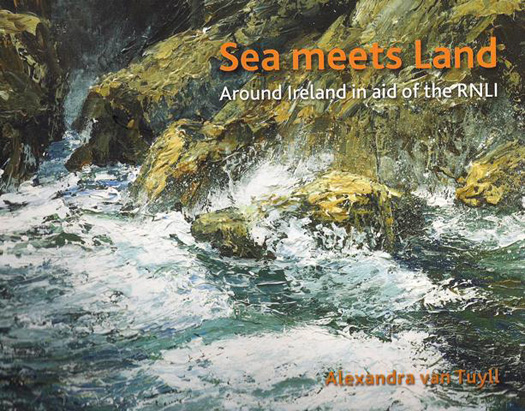
Achill RNLI Book - Sea meets land
Operations Manager at the Achill RNLI Tom Honeyman and the crew and fund-raising supporters invited me to visit the station, a modern building at Cloghmore in the southern part of Achill Sound. The station was established in August 1996 and its all-weather lifeboat is kept on moorings. It is always a pleasure to meet and talk with lifeboat people and this visit underlined the huge community involvement with and pride in the lifeboat.
I wish Alex and the Achill Station every success with the book. It has been published by and is available from Achill Art Press Slievemore Road, Keel, Achill, Co.Mayo or by Emailing: [email protected]
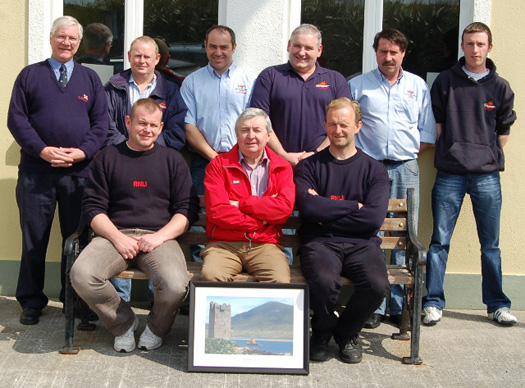
With the Achill Island lifeboat crew
FISHING INDUSTRY NEEDS LOCAL MANAGEMENT
Giving more power to local communities in the fishing industry must be encouraged. There is too much dominance by State and European bureaucracy which has not been helpful. This is underlined in a community-led report published in the biggest whitefish port in the country, Castletownbere in West Cork.
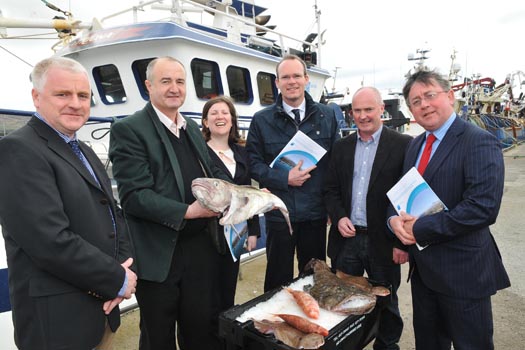
Castletownbere fishing strategy presented to Marine Minister Simon Coveney. L. to R. Liam O'Driscoll, Vice Chairman Irish South and West Fish Producers' Organisation; John Nolan, Castletownbere Fishermen's Co-op; Eibhlin O'Sullivan, CEO, ISWFPO; Minister Simon Coveney; Frank Fleming, 'Responsible Irish Fish' organisation and Michael Keatinge, BIM Fisheries Development Manager.
More than half the economic life of Castletownbere depends on the offshore fishing industry. With fish farming and ancillary activities added that dependence increases to 86 per cent. The economic figures, revealed in the report compiled by the State fisheries Board, BIM and local fishing industry organisations, underline how vital the industry is to coastal areas. It provides 81 per cent of all employment in the town. The money spent by those employees keeps business turning over.
The proposals were presented to Marine Minister Simon Coveney. Key actions proposed include improved co-operation in the catching sector; new gear adaptations and techniques; tuna and boarfish processing locally; a frozen prawns brand and an increase in aquaculture development and processing.
SHIPPING
Cork Mariner Appointed European Chairman
Captain Michael McCarthy, formerly Deputy Harbour Master in the Port of Cork and now its Commercial Manager, has been elected Chairman of the Cruise Europe organisation which has a hundred member groups in the Atlantic Europe and Baltic Region, including Portugal, Russia, Iceland, Scandinavia, Norway and the UK, developing the cruise ship business. He has been involved in the maritime sphere for 40 years, as a Master Mariner, Ships' Captain and marine surveyor.
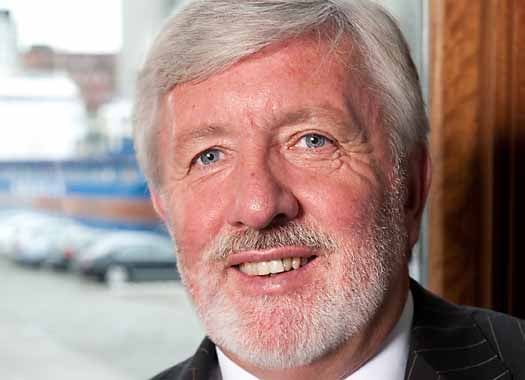
Captain Mike McCarthy of the Port of Cork
The cruise industry faces major challenges, not just from recession but the effect on public confidence of the Costa Concordia disaster in January and other emergencies at sea involving cruise ships, as well as rapidly increasing operational costs, such as fuel.
"The organisation provides cruise ship owners with top-class destinations of which Ireland is a major one. There are over 200 cruise calls to Ireland a year carrying half-a-million passengers and crew. This is worth €60 million," Capt. McCarthy said.
World Harbour Masters Visit Cork
The 8th International Harbour Masters Association (IHMA) Congress, "Global Ports & Marine Operations" will be underway from Monday, May 14, in Cork City Hall. The Congress is held every two years and this is the first time it is being held in Ireland. An attendance of 300 local and international harbour masters is expected to hear 30 leading industry speakers.
MARINE ENVIRONMENT
More Water Moved
More water moved into and out of the atmosphere in 2000 than in 1950, making parts of the world's oceans saltier and fresh waters less salty according to American researchers this week. A warming planet may be to blame. Evaporation and rainfall increased by 4 per cent as surface temperatures rose half a degree. That is a bigger change than previous studies suggested, but underlines that a warmer atmosphere can hold more moisture.
EXPLORATION
Oil Day In China
China brought its first home-made, deepsea, semi-submersible oil drilling rig into operation on Wednesday. This starts the country's offshore exploration programme. The new rig, Ocean Oil 981, took six years to build and has been towed to the eastern region of the South China Sea to begin 56 days of drilling to a depth of over 7,000 feet. It is being operated by the State-run National Offshore Oil Corporation and is another stage in Chinese economic development.
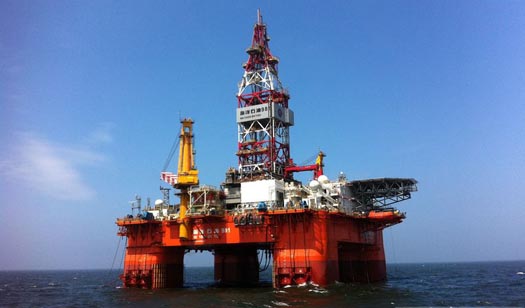
You can Email me to: [email protected]
Follow me on Twitter: @TomMacSweeney and on Facebook
GET THE MONTHLY NEWSLETTER: Sign-up at: [email protected] to receive my monthly newsletter summary to your Email on the first Friday of each month. Please put 'newsletter' in the subject line of your email.


























